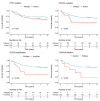Genomic Signature of Oral Squamous Cell Carcinomas from Non-Smoking Non-Drinking Patients
- PMID: 33804510
- PMCID: PMC7957667
- DOI: 10.3390/cancers13051029
Genomic Signature of Oral Squamous Cell Carcinomas from Non-Smoking Non-Drinking Patients
Abstract
Molecular alterations in 176 patients with oral squamous cell carcinomas (OSCC) were evaluated to delineate differences in non-smoking non-drinking (NSND) patients. Somatic mutations and DNA copy number variations (CNVs) in a 68-gene panel and human papilloma virus (HPV) status were interrogated using targeted next-generation sequencing. In the entire cohort, TP53 (60%) and CDKN2A (24%) were most frequently mutated, and the most common CNVs were EGFR amplifications (9%) and deletions of BRCA2 (5%) and CDKN2A (4%). Significant associations were found for TP53 mutation and nodal disease, lymphovascular invasion and extracapsular spread, CDKN2A mutation or deletion with advanced tumour stage, and EGFR amplification with perineural invasion and extracapsular spread. PIK3CA mutation, CDKN2A deletion, and EGFR amplification were associated with worse survival in univariate analyses (p < 0.05 for all comparisons). There were 59 NSND patients who tended to be female and older than patients who smoke and/or drink, and showed enrichment of CDKN2A mutations, EGFR amplifications, and BRCA2 deletions (p < 0.05 for all comparisons), with a younger subset showing higher mutation burden. HPV was detected in three OSCC patients and not associated with smoking and drinking habits. NSND OSCC exhibits distinct genomic profiles and further exploration to elucidate the molecular aetiology in these patients is warranted.
Keywords: CDKN2A; DNA copy number; EGFR; PIK3CA; TP53; alcohol; human papilloma virus; oral cancer; targeted sequencing; tobacco.
Conflict of interest statement
The authors declare no conflict of interest.
Figures






Similar articles
-
TP53 mutations and CDKN2A mutations/deletions are highly recurrent molecular alterations in the malignant progression of sinonasal papillomas.Mod Pathol. 2021 Jun;34(6):1133-1142. doi: 10.1038/s41379-020-00716-3. Epub 2020 Nov 17. Mod Pathol. 2021. PMID: 33203919 Free PMC article.
-
Comprehensive genomic profiling of head and neck squamous cell carcinoma reveals FGFR1 amplifications and tumour genomic alterations burden as prognostic biomarkers of survival.Eur J Cancer. 2018 Mar;91:47-55. doi: 10.1016/j.ejca.2017.12.016. Epub 2018 Jan 11. Eur J Cancer. 2018. PMID: 29331751
-
Whole-Exome Sequencing Analysis of Oral Squamous Cell Carcinoma Delineated by Tobacco Usage Habits.Front Oncol. 2021 May 31;11:660696. doi: 10.3389/fonc.2021.660696. eCollection 2021. Front Oncol. 2021. PMID: 34136393 Free PMC article.
-
Translational genomics and recent advances in oral squamous cell carcinoma.Semin Cancer Biol. 2020 Apr;61:71-83. doi: 10.1016/j.semcancer.2019.09.011. Epub 2019 Sep 19. Semin Cancer Biol. 2020. PMID: 31542510 Review.
-
Translational Research: A Future Strategy for Managing Squamous Cell Carcinoma of the Head and Neck?Anticancer Agents Med Chem. 2018;18(9):1220-1227. doi: 10.2174/1871520618666180411110036. Anticancer Agents Med Chem. 2018. PMID: 29637868 Review.
Cited by
-
Non-smoking and Non-drinking Oral Cancer Patients Are at Higher Risk of Second Primary Tumours.Oral Dis. 2025 Jul;31(7):2129-2138. doi: 10.1111/odi.15235. Epub 2024 Dec 30. Oral Dis. 2025. PMID: 39737774 Free PMC article.
-
Enhancing oral squamous cell carcinoma prediction: the prognostic power of the worst pattern of invasion and the limited impact of molecular resection margins.Front Oncol. 2023 Dec 22;13:1287650. doi: 10.3389/fonc.2023.1287650. eCollection 2023. Front Oncol. 2023. PMID: 38188288 Free PMC article.
-
Molecular drivers of oral cavity squamous cell carcinoma in non-smoking and non-drinking patients: what do we know so far?Oncol Rev. 2022 Feb 22;16(1):549. doi: 10.4081/oncol.2022.549. eCollection 2022 Feb 22. Oncol Rev. 2022. PMID: 35340886 Free PMC article.
-
Epigenetic Regulations of Perineural Invasion in Head and Neck Squamous Cell Carcinoma.Front Genet. 2022 Apr 27;13:848557. doi: 10.3389/fgene.2022.848557. eCollection 2022. Front Genet. 2022. PMID: 35571032 Free PMC article. Review.
-
Comparison between three age-stratified cohorts reveals poor prognosis of young patients with tongue carcinoma.Front Oncol. 2022 Sep 2;12:959749. doi: 10.3389/fonc.2022.959749. eCollection 2022. Front Oncol. 2022. PMID: 36119483 Free PMC article.
References
Grants and funding
LinkOut - more resources
Full Text Sources
Other Literature Sources
Research Materials
Miscellaneous

